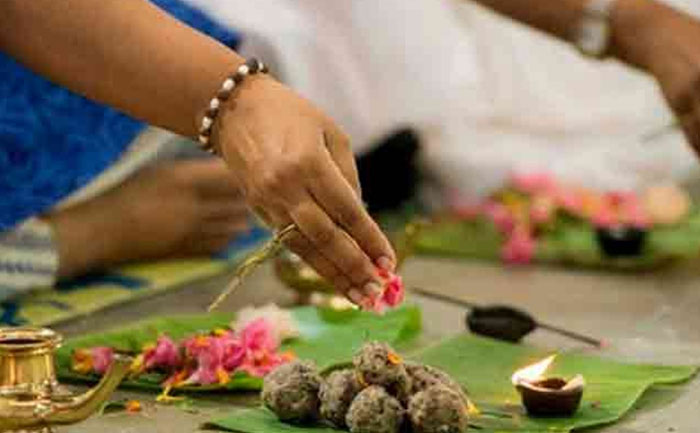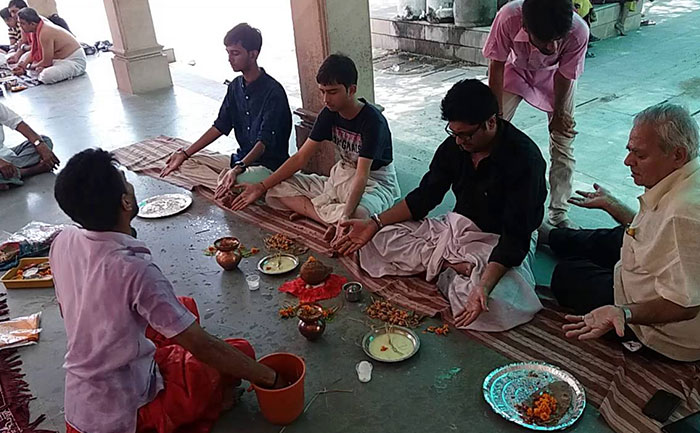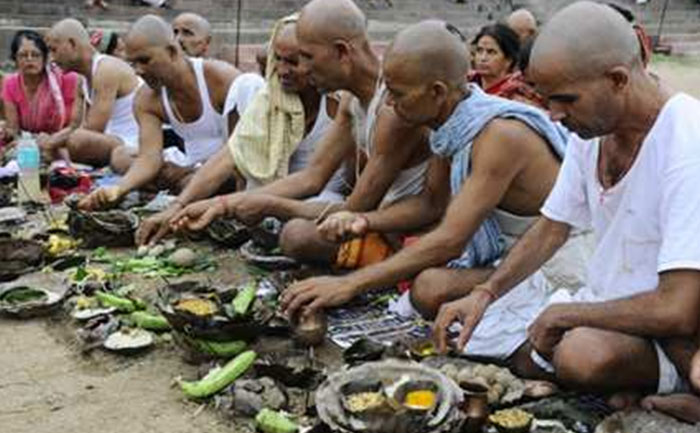- Sponsored -
Pitru Paksha 2019: Dates, History, Reason, Significance, Dos and Don’ts
Pitru Paksha 2019 begins from September 13 to September 28, here are the dates, history and do's dont's for the rituals

After celebrating Ganesh Chaturthi and later bidding farewell to Lord Ganesha, Pitru Paksha begins, it is a 16 day period when Hindus honour their ancestors and pay respect to them by offering food and water. Pitru Paksha begins on the first full moon (Purnima) following Ganesh Chaturthi and ends on the Peddala Amavasya. It is believed that during the time of Shradh, ancestors come to earth to bless their kin.
- Sponsored -
Significance Of Shradh:

Shradh liberates the soul from the cycle of life and death resulting in salvation. Hence, performing Shradh during the time of Pitru Paksha is considered extremely important for the departed souls to rest in peace. Tarpan, during the time of Shradh, is equally necessary in order to get rid of Pitra Dosh (bad effects due to the non-performance of rituals of the departed souls).
History:
The relevance of Shradh can be best known from one of the greatest epics of all time Mahabharata.
Post the war between the Kauravas and Pandavas, when everything ended, Karna died and reached heaven, but instead of food and water, he received only gold and jewels. An exasperated Karna asked Indra the reason for offering him such food. On this, Indra told Karna that throughout his life he had donated gold, diamond and silver, but, never donated any food in the name of his ancestors. Karna replied that he had no idea who his ancestors were. After hearing him out, Lord Indra allowed Karna to return back to Earth for the period of 15 days so that he can donate food to his ancestors. This 15-day period came to be known as Pitru Paksha.
Sarvapitri Amavasya:

The last day of Pitru Paksha is known as Sarvapitri Amavasya or Mahalaya amavasya. A person who does not know the exact date of their ancestor’s death anniversary, they pay homage and offer food on this day.
On the Amavasya Shradh, in the evening, a special (Atta or flour) Diya is lighted. This lighting of Diya signifies Pitru Vidaai (final goodbye) to the departed souls.
Holy Places For Shradh Rituals:

As per the Hindu mythology, these are some important places in India for performing the rituals of Shraadh:
- Varanasi, Uttar Pradesh
- Prayaga (Allahabad), Uttar Pradesh
- Gaya, Bihar
- Kedarnath, Uttarakhand
- Badrinath, Uttarakhand
- Rameswaram, Tamil Nadu
- Nasik, Maharashtra
- Kapal Mochan Sarovar, Yamuna Nagar, Haryana
Pitru Paksha Shraddh – Customs And Traditions:
The process of Shradha ritual may be different from one person to the other but usually, it has 3 parts:-
1. The first part is called as Pind Daan where Pind is offered to the Pitrus (Ancestors). Pind is nothing but the rice balls which are usually made with the Ghee, honey, rice, Goat’s milk, sugar and occasionally barley.
2. The second part is Tarpan where water mixed with flour, barley, Kusha Grass & black sesame is offered to the Ancestors.
3. The third is offering food to the Brahmin priests.
Shradh Rituals:

There are certain rituals which are performed during the Pitru Paksha Shradh. It is believed that if these rituals are performed with full faith, devotion, and respect, the departed souls will rest in peace and they will protect us from all the negatives and evils.
The rituals of Shraddh are as follows:
- It is believed that Shraadh of any ancestor or any departed soul in the family should be performed by any male member. It could either be the eldest son of the departed soul or the head of the family.
- During the time of Shraddh, one should pray religiously and control one’s anger.
- On the various Tithi of Shraadh, Brahmins are invited at home and special prayers (Tarpan) are offered to the departed souls. Post the ritual of Tarpan, Brahmins are offered home-cooked food, brand new clothes, special sweets and Dakshina (money). It is a belief that this Brahman Bhoj reaches the ancestors.
- Along with the Brahmins, a crow is also fed with the same food, as the crow is believed to be the messenger from Yama. Along with the crow, dog and cow are also fed.
- During the time of Shraadh, one can make Mahadan (big donation). This ritual is performed in order to free oneself from the Pitra Dosha.
Who should perform Shraddha?

It is essential that Shraddha is performed by the son usually the eldest or male relative of the paternal branch of the family, limited to the preceding three generations. However, on Sarva pitru amavasya or matamaha, the daughter’s son can offer Shraddha for the maternal side of his family if a male heir is absent in his mother’s family.
Daughters too can perform Shradh. If pitru tharpanam is done by a female then one must use white sesame seeds in the shradh puja instead of black sesame seeds.
At what date should Puthar Shraddha:
In simple words, Shradh is remembered on the date of his death of the departed soul. If a person’s family death is on Pratipada, it should be done only on the day of Pratipada. Below are the days as per belief whom we offer Shradh to ancestors:
- Father’s Shradh is done on Ashtami and the Mother’s shradh is done on Navmi
- In the case of premature death, i.e., due to an accident or suicidal cause, shradh is done on Chaturdashi.
- Dasvi Shraddha is donated to sanyasi or monk
- If anybody does not know the date of death of his ancestors, then it is done on Amavasya. This date is called Shraddha for all the ancestors.
Benefits of Shraadh during Pitru Paksh:

- Provides cordial and harmonious family relations
- Relief from physical and mental ailments
- Provides financial stability and peace of mind
- Relief from malefic effects of Pitru Dosh
Dos and Dont’s during Pitru Paksha:
- During Shraadh, try to restrain yourself from doing all the things mentioned below:
- Avoid buying any new clothes during the time of Pitru Paksha.
- Any auspicious event like marriage or birth ceremony is completely prohibited during the time of Shraadh
- Try to avoid having a haircut during the sixteen days of Shradh.
- Restrain from eating non-vegetarian food, alcohol and tobacco during the time of Shraadh.
- Try to avoid eating at others’ house during the time of Shraadh. It is considered that if you eat (salt debt) at someone’s home their Pitru is transferred to the host. This can only be removed by balancing the act or through a remedial Pooja.
Shradh 2019 Start and End Dates:
- 13 September (Friday) Purnima Shraddha
- 14 September (Saturday) Pratipada Shraddha
- 15 September (Sunday) Dwitiya Shraddha
- 17 September (Tuesday) Tritiya Shraddha
- 18 September (Wednesday) Maha Bharani, Chaturthi Shraddha
- 19 September (Thursday) Panchami Shraddha
- 20 September (Friday) Shashthi Shraddha
- 21 September (Saturday) Saptami Shraddha
- 22 September (Sunday) Ashtami Shraddha
- 23 September (Monday) Navami Shraddha
- 24 September (Tuesday) Dashami Shraddha
- 25 September (Wednesday) Ekadashi Shraddha, Dwadashi Shraddha
- 26 September (Thursday) Magha Shraddha, Trayodashi Shraddha
- 27 September (Friday) Chaturdashi Shraddha
- 28 September (Saturday) Sarva Pitru Amavasya
Pitru Paksha Shradh is Parvan Shradh and auspicious time to perform them is either Kutup Muhurat or Rohina Muhurut. Muhurat elongates till Aparahna Kala gets over. Tarpan is done at the end of the Shraddha.
Shradh Muhurat timings:
Kutup Muhurat: 11:52 am to 12:41 pm
Rohina Muhurat – 12:41 pm to 01:30 pm
Aparahna Kaal – 01:30 pm to 03:57 pm
Also Read: Ganesh Chaturthi 2019: Significance, Date, Time and Puja details
- Sponsored -
